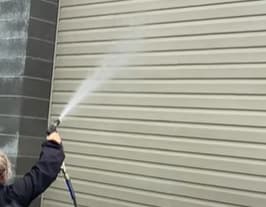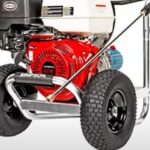As an Amazon Associate, this site earns commissions from qualifying purchases. For more information click here.
Pressure washing a house is an inexpensive and effective way to remove grime, mold and other debris. You only have to do this once every few years, and you can buy or rent machine.
If you have never done this before, no worries. I will walk you through the process step by step. In a nutshell this is what you have to do:
Start spraying and scrubbing the floor and work your way up the walls. If your house has two floors, begin at the second story. Cover doors and windows to protect them from the water.
Tools and Materials
- Pressure washer (Bilt-Hard gas models are well suited for these)
- Brush
- Bucket (5 gallons, adjust if needed)
- Water
- Bleach
- Mildewcide detergent (my pick is Bio Cide mold and mildew cleaner)
- Cloths or plastic sheeting
- Duct tape
- Scaffolding
- Goggles
- Gloves
- Garden sprayer
Before You Start
If your house hasn’t been pressure washed in years, it’s going to take a few hours to clean it. It’s also going to require more than just pressure washing, as you’ll have to hand scrub as well.
If you have a two-story house, pressure washing and cleaning will be even longer. You might want to consider hiring a professional to do the job for you. If you still want to do this, follow the steps here.
Which Pressure Washer to Use?
If you don’t have a pressure washer, you can buy or rent one. A rental vendor can provide you with the right machine for your home.
If you’re going to buy, I recommend a gas pressure washer. They are more powerful than electric models and easier to maneuver because they’re not attached to a cord.
What Pressure Washer PSI to Use?
It depends on the materials. For steel, stone, concrete and brick, 2500 to 3000 PSI. For aluminum, stucco, softwood and vinyl siding, 1300-1600 PSI. Use very low PSI for glass and cement fiber.
If you are pressure washing the driveway, I can recommend 2800-3000 PSI.
Step 1: Cover Doors, Windows and Plants
Cover the doors, windows, plants and outdoor furniture with plastic sheeting or cloth. Apply duct tape to secure the sheeting or cloth.
Cover lights and other electrical fixtures. Water and electricity should never mix.
Remove toys, bicycles and other objects nearby. Clear the grounds with a broom or leaf blower. You’ll be stepping on a wet surface, and you don’t want to trip over something.
This video shows you how to pressure wash a house.
Step 2: Prepare the Detergent
Prepare the washing solution in the bucket. If the walls have mold or mildew, mix water with mildewcide and bleach.
Which detergent to use depends on your house’s siding materials. If the walls don’t have any mold or mildew, detergent alone is fine. For hard to remove dirt, bleach is ideal. Pour the mixture into the sprayer.
Step 3: Get the Pressure Washer Ready
Plug the garden hose into the pressure washer. Adjust the setting to the appropriate PSI.
Snap the nozzle onto the wand. A 15 degree (yellow) nozzle is fine for hard surfaces. For softwood and softer materials, use a 25 degree (green) nozzle and a low PSI.
Wear goggles for eye protection. You’ll get splashed on so wear clothing that will protect you.
If you have a two-story house, prepare the scaffolding. Set up the scaffolding so that you have a reach of 3 feet when holding the pressure washer wand. Secure the scaffolding wheels.
Step 4: Bottle Spray the Surface
Spray one section at a time. You can divide the house into 10×10 ft (smaller or larger depending on your home).
Begin at the floor and spray it with the bleach detergent mix. Scrub the floor thoroughly. Spray and scrub the entire section. Use the same procedure for each area of the house you’ll clean.
If you have a two-story home, it’s best to have someone looking over you while you get on the scaffolding.
Step 5: Pressure Wash a Section

After spraying and scrubbing one section, stand 3 feet from the wall and turn the pressure washer on.
Keep this distance if you can remove the dirt. If not, move 5 inches closer. Continue moving closer by 5 inches until dirt starts to come off.
Once you find the right distance, pressure wash from the top. While you scrub and spray from the floor first, here you pressure wash from the gutters and work downwards.
Step 6: Move to the Next Section
Move on to the next section. Again, start from the bottom, spray and scrub thoroughly. Pressure wash from the top and work your way down.
Keep repeating until you gone over all the sections. Remove the duct tape and plastic sheeting and you are done.
Safety Guidelines
Always wear goggles no matter what you’re pressure washing. The force can tear through skin so wear long sleeve clothing too.
You should also wear shoes to protect your feet and to avoid slipping on the wet surface. Gloves are a personal preference. But if you do wear them, make sure it doesn’t affect your grip on the wand.
Never use a ladder to pressure wash a multi-story house. Pressure washers generate recoil that can cause you to lose balance. A scaffolding is a more secure option.
Do not pressure wash anywhere near electrical outlets or fixtures. Stay at least 6 feet away from electrical lines.
Why You Should Pressure Wash Your House
Pressure washers are cost effective. It uses less water than a regular garden hose but does a better job removing dirt.
If you plan to paint your house, pressure washing is a great way to prepare the surface. As a general cleaning tool, pressure washers are faster, cleaner and more effective than hand scrubbing and garden hosing.
Pressure washers are strong enough to remove old paint. You’ll still need to scrape some material off, but it helps speed up the process.
Because pressure washers have different nozzles and adjustable PSI, you can use it on different sidings. As long as you use the right PSI and nozzle, it won’t cause any damage.
Frequently Asked Questions
Can pressure washing remove mildew/mold?
Pressure washing the mildew/mold with bleach and water will remove it. But you have to use a mildewcide or a mold spray solution to remove it completely. Otherwise it’s going to come back.
How do I prevent water getting up below the siding?
Hold the wand at a lightly downward or horizontal angle. It might help to hold the wand with two hands for a steadier grip. Start 3 feet from the surface you want to wash. Move closer if necessary to remove the dirt.
How do you pressure wash soffits?
Point the wand at an upward angle. Try not to get any water into the vents or cracks. Be careful and avoid spraying lights and other fixtures.
Can I paint my house after pressure washing?
Wait at least a week after pressure washing to apply paint. This ensures the surfaces are all dry.
You can use the 15 degree nozzle to wash rugged surfaces. It’s also powerful enough to remove old paint.
But I wouldn’t recommend using a pressure washer to eliminate old paint. Think of it as a washing tool first and foremost. After washing, remove whatever’s left of the old paint, then you can repaint the surface.
Can I use chlorine to pressure wash my house?
I recommend using water and a detergent formulated specifically for pressure washers. In most cases this solution removes all kinds of dirt and grime.
If that doesn’t work, you may combine 1 gallon of water with 1/4 chlorine. Use this only on hard surfaces with caked dirt.
Should I use soap or detergent with my pressure washer?
As long as either is labeled for pressure washers, it is safe to use. Some detergents are made for specific surfaces like concrete or wood, and the same goes with soap.
When is the best time to pressure wash a house?
Bright sunny weather is ideal. The drier the conditions, the faster your house is going to dry.
Can pressure washer PSI damage my house?
Concrete, brick, stone and unpainted surfaces can handle high pressure washer PSI. Softwood and other materials need to be washed more gently.
The distance is also important. Stand at least 3 feet from the surface you’re spraying to give yourself enough room.
Can I use an electric pressure washer to clean my house?
Yes, but it’s going to take more time. Most gas models have a range of 2000-3000+ PSI while electric models are at 1500-1800 PSI
The higher the PSI the more efficient the wash. Electric pressure washers can also be difficult to maneuver because it is plugged into a power outlet.

I love the outdoors and all the tools for maintaining gardens, yards and lawns. The only thing I am more passionate about is sharing what I know about garden and outdoor equipment.


